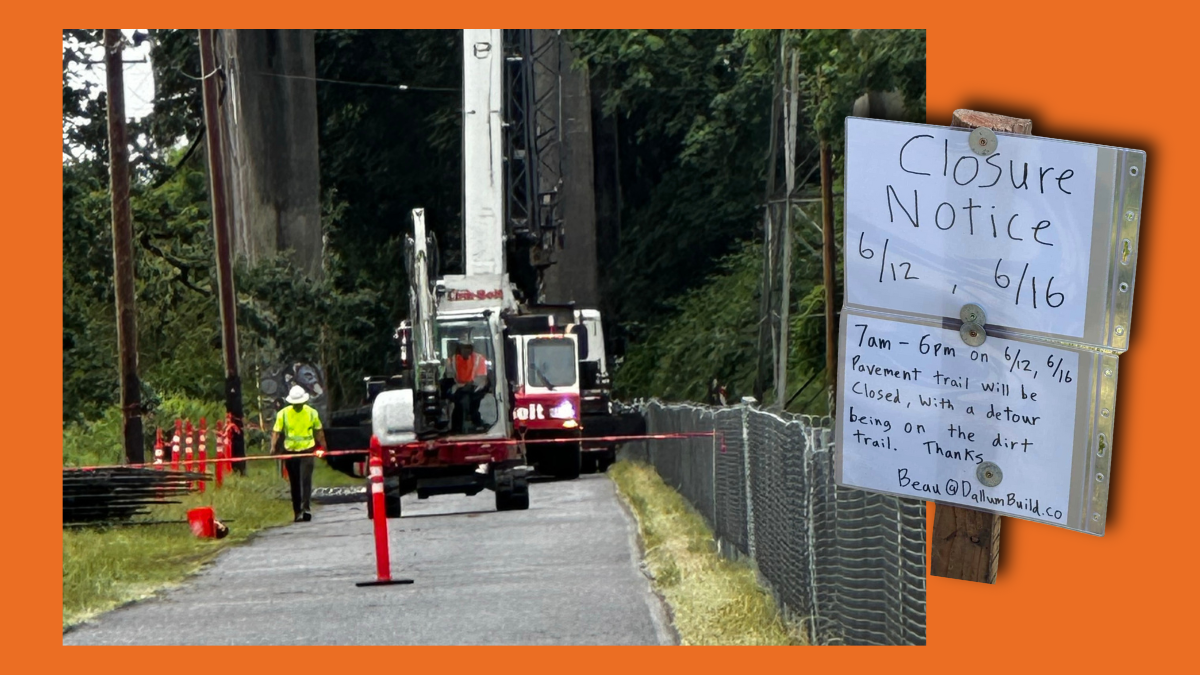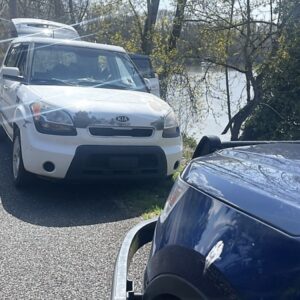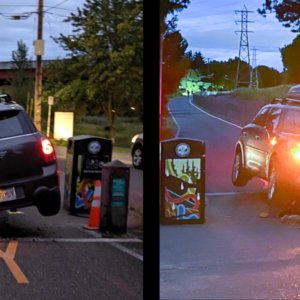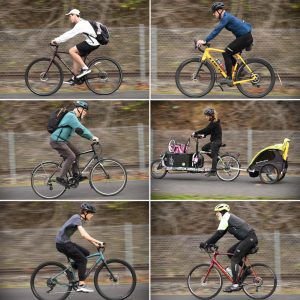
A contractor hired by the Oregon Department of Transportation to do work on the McLoughlin Viaduct in southeast Portland near the Ross Island Bridge has blocked the Springwater Corridor path several times. That’s not a big deal, except that the community was given zero notice of the project. And the project began with ODOT not following the proper permitting and community notification procedures.
Several BikePortlanders have reached out wondering what’s going on. Here’s the deal…
After receiving photos and messages about the path blockage from a few of you, I reached out to Portland Parks & Recreation to ask what was going on. The Springwater path is a crucial link in our transportation network. For bicycle riders it’s just as important (if not more so) as Highway 99E that runs adjacent to it. So when I saw photos of a large crane and piles of fencing materials blocking the entire paved path, I wondered why I wasn’t notified about the closure. Whenever there’s even the slightest impact to the Springwater path due a construction project, Parks has a standard procedure for permitting, public notification, and detours. Ironically, I often get these closure notices and don’t even share them because the impacts are so minor. But this is not a minor impact.
(NOTE: Before this post gets totally misunderstood by haters, no, I’m not “in a rage” about this. The blockage of the path isn’t a huge deal in the grand scheme of things, I’m just telling folks what happened because I’m getting a lot of questions about it.)
This crew is working on a project that includes fencing off space under the viaduct and highway (which I assume is related to keeping campers out). The location was too hard to reach from the highway, so they changed their approach and used the path. That’s where things went south. Beginning just over one week ago, people began telling me about the blockage and how there was zero advance warning of it. When I notified Parks about the situation, they were surprised too and said a permit was still in process.
So, an ODOT contractor blocked a busy section of the Springwater Corridor path without even getting the proper permit from Parks and without following signage and detour standards?
I reached out to an ODOT spokesperson on Monday to learn more. Here’s what David House, who works in ODOT’s Region 1 public affairs office, told me:
During contractor work under the McLoughlin Viaduct on OR 99E, the contractor first tried to reach the worksite from 99E to delivery materials but needed to switch to the Oregon Pacific Railroad right-of-way and the park. Although we got access to the work site from the trail to deliver materials, we were not at first aware that Portland Parks & Recreation required notification and posting. So we and the contractor apologize for this and have corrected it.
Going forward, we have implemented a signing plan for advanced notification on the trail and are able to detour cyclists and pedestrians around the crane outriggers using the gravel trails adjacent to paved surface. Fortunately, the weather is dry, and the trails are firm.
Our contractor is telling us that they only think they have one more day of moving materials into place.
We apologize for the lack of advance notice about the trail detour.
After I connected with ODOT, one of the contractors posted a handwritten sign on the path. The sign tells people that the path will be blocked two more times before the project wraps up and that the detour is to just go around and use the singletrack dirt trail along the riverfront. If you ride this section of the Springwater, be aware of this detour today (June 12th) and and June 16th.
Thank you to the readers who gave me the heads up and shared photos about this.






Thanks for reading.
BikePortland has served this community with independent community journalism since 2005. We rely on subscriptions from readers like you to survive. Your financial support is vital in keeping this valuable resource alive and well.
Please subscribe today to strengthen and expand our work.
I crashed my cargo bike trying to navigate the unexpected “detour”. I was heading north and successfully transitioned to the single track and when I was past the crane I went through tall grass trying to get back on the pavement and found a deep dip that was hidden by the grass and down I went. No major injuries since I was going about 5mph, just ruined shorts and a bruised ankle. There was zero effort to make a safe detour just red tape blocking the path
You should file a claim for damages against ODOT. Their contractor probably has insurance for this kind of thing.
Until ODOT and contractors feel it in their pocketbook, their attitude toward bikes will never change.
Seriously, what Fred said. There are lots of good attorneys who advertise on Bike Portland who could help you file your claim. Even better if you took pictures (scene, damage, injury), which everyone should if they experience a crash like this.
They were going to fast for conditions and should have known better. Isn’t that what we say about drivers?
Maybe they can try suing the campers/miners who have spent the last few years undermining the footings on that viaduct.
I’m curious as to the thickness of the asphalt and the weight of the crane. Did this damage the path?
No, because I was holding their crane up with my crane that I keep with me just for issues like this, see post below for more deets.
Last time this happened, I bought a chainsaw to make the “detour” even remotely passable. At least the dirt there is rideable. But yeah, just more of the same. They’ll do it again, too.
Good call, I bet that two stroke firing up caught them by surprise. Similar to the last time I encountered this, I had luckily brought my own crane, so I just lifted their crane out of the way and rode under it and was off to work in a few mins, wasn’t even late. A couple other commuters we’re like, “dude that is such a good thing to have on hand for stuff like this” and I was like, “yeah”.
I’ve scheduled a Sikorsky Skyhook (some people call them “Skycranes” to be on duty twice a day to lift the ODOT crane out of my way while I travel to and fro on the Springwater for the next few days. (My roadbike has skinny 25’s and I’m afraid I might flat using those dirt paths.) Let me know if your crane needs to be rigged and lifted so I can give the skyhook operators a heads-up.
COTW, So smart, you’re living in 3025 while the rest of us are just NPCs.
What is even the point of requiring a permit and public notification if ODOT is going to allow contractors to do this work without these “requirements”? ODOT is clearly aware they lacked a permit and failed to perform proper notification and still let the contractor block the path and continue the work? This is utterly flabbergasting and totally unacceptable that ODOT and PP&R would knowingly let them continue without following proper procedure and cause this sort of disruption.
What would you propose? Fire the contractor and put the project back out to bid? If you were the ODOT project manager and getting heat from above to get this dealt with, how much more money and time would you ask for?
I propose that the contractor wait until permits have been obtained & public notification has been made. It was the contractor’s fault for changing their project parameters, and they should bear the financial impact because of their decision to change. Otherwise, under your logic of letting them continue without permits and proper notification simply proves my point – why have any such requirements if they aren’t actually going to be required?
On a related note, I was walking this morning across N Concord Ave, which is the Beach Middle School bike-to-school route and PGE closed off the whole street without warning. There were dozens of bicyclists on a bike bus (half of which were children) not given a detour route. One block over is Interstate Ave (not great for biking with children) and the other block over is Denver Ave, which gets a good bit of auto traffic. It seems like there should be better protocols in place for closures of bike facilities where parallel routes are lacking.
Sounds like a good teachable moment in how to safely troubleshoot a situation you might come across when riding a bike.
Because that’s just the sort of stuff a bike rider should expect?
Life has enough teachable moments without the DOT and other big dogs piling on.
Two places where construction workers tend to miss out: 1) soil is alive? 2) what are bikes?
Bike riders should in fact, expect the unexpected. That way of thinking can help keep you safe. Teaching young riders to navigate and troubleshoot is essential in being a safe confident cyclist.
It would be great to have the DOTS remember to include all road users in their thoughts on closures but in the end, looking out for yourself is an important skill to have.
Bike trains are fun and communal but they are a beginner commuting technique too and some educational content should be included in the party if it isn’t already.
I think things not going to plan and encountering unexpected conditions are part of life. Be able to think on your feet and adapt to new situations is a good skill, right? (in general, not just for cycling).
I am curious: how would the construction industry change if they acknowledged the biota in soil?
agreed on the multitude of bike route street closures lately. I usually find that one or the other sidewalks are open through the construction zone, and I’ve also had success approaching the crew and asking if I may proceed after first checking for heavy equipment movement. Our small size and nimbleness often allows us to navigate “closed” areas without disturbing the wildlife.
It would be interesting to read the original easement language on the path, to see if contractors are “required” to have an access permit or if it’s just out of courtesy. My guess it’s the latter, which is the case in most jurisdictions – part of the definition of “right-of-way” is that anyone may access a route, including transportation users, agencies, contractors, parks users, and I suppose “illegal” campers – all part of our collective response and continuing conflict within the public commons.
There’s a huge difference between using a right of way to access a site and parking your ten ton crane in the middle of the right of way and totally preventing others from using it for several hours.
The problem is not that the contractors used the springwater to access a worksite, it’s that they turned the springwater into a worksite workout warning or permission.
I disagree! It’s a huge deal if you depend on the Springwater to cycle to work.
And unlike detouring in a car, where you harumph and throw the 180 horses into reverse and choose from dozens of other driving options, detouring on a bike requires SO MUCH EXTRA EFFORT to find another suitable route, with lots of climbing etc. A so-called simple detour can add HOURS to a bike commute.
I see what happened here: a work crew just thoughtlessly blocked a major bikeway cuz they could. It happens all the time in Portland! Until the default position changes, cycling will never be the default way to get around in Portland.
I think it’s gone beyond something that happens intermittently — it’s now utterly normal to find a major bikeway blocked in Portland without any attempt at detour or mitigation. And, ironically, PBOT itself is a source of many of these blockages.
Yes, PBOT often causes blockages, and often violates laws (while displaying their VISION ZERO stickers).
One of my worst personal experiences of this type was a small PBOT project. The contractor parked a large cement truck across a marked crosswalk, forcing people to walk blindly into oncoming Highway 43 traffic. When I pointed that out, quietly and sanely, the contractor, with a PBOT supervisor standing next to him, threatened to have me arrested for “construction site interference”. Then the PBOT supervisor mockingly said, “Call Rhetta Monday” (Rhetta being the PR person associated with the project).
PBOT enforcement staff have helped me go after PBOT construction project blockages. They’ve told me PBOT can be horrible at following regulations.
Agreed. They were trimming trees along the Springwater a couple miles from Boring and I had to go through Camas, WA to get back to Portland. Who do they think we are, Tour de France riders, geeze the wheeze, right?
Agreed 100%. When I lived in Sellwood, I depended on this route to get to work every day that I biked. That’s a very long distance to bike to then have to completely turn around and head back to the Sellwood bridge, or try and heave-ho up the very steep path going up to Milwaukie Ave.
John waving at his haters… i hope the peasants enjoy the @, it’s very charitable of him
For me, riding in Bend, the small construction mistakes are the ones that are most dangerous. Two examples: work is being started today on my main feeder street. The contractor put warning signs up in the bike lane over the weekend. But, they were the fabric style, which roll up when not in use. Rolled up, on a dark metal stand, turned sideways, they are invisible at night, and barely visible during the day. You would hit the sturdy metal tripod stand and crash for sure. OR, another location, they cut out about a 4 square foot portion of asphalt in the bike lane, probably to later install a drain, or something. They then filled the cutout with large diameter gravel. It is the same color as the asphalt, so you only see it at the last second. Not big deal if you have fat tires, but an almost certain crash at 20 mph with narrow racing tires. I know the kinds of people that work on these projects; they are just regular guys, rarely cyclists, so it is not even in their thoughts about potential danger to riders. Any bike crash would result in significant financial liability to the contractor. As a former builder myself, I was always thinking about worst case safety scenarios.